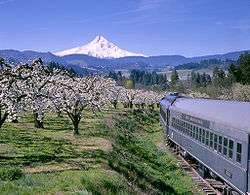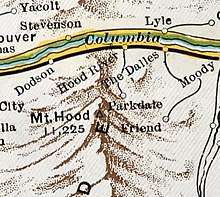Mount Hood Railroad
The Mount Hood Railroad (reporting mark MH) is a heritage and shortline freight railroad located in Hood River, Oregon, 60 miles (97 km) east of Portland, Oregon, United States.
| Mount Hood Railroad | |
|---|---|
 The Mount Hood Railroad in spring, with Mount Hood in the background. | |
| Terminus | Hood River, Oregon - Parkdale |
| Commercial operations | |
| Original gauge | 4 ft 8 1⁄2 in (1,435 mm) |
| Preserved operations | |
| Preserved gauge | 4 ft 8 1⁄2 in (1,435 mm) |
| Commercial history | |
| Opened | 1906 / 1909 |
| Closed | 1987 |
| Preservation history | |
| 1987 | Bought by private investors |
| 2008 | Sold to Permian Basin Railways |
| Website | |
| mthoodrr | |
Mt. Hood Railroad Linear Historic District | |
Railroad depot in Hood River | |
| Location | Mt. Hood RR right-of-way from Hood River to Parkdale, Hood River, Oregon |
| Area | 165 acres (67 ha) |
| Built | 1906 |
| Architect | Joseph A. West (design/construction) |
| NRHP reference No. | 93001507[1] |
| Added to NRHP | January 24, 1994 |
The majority of the railroad's revenue is generated from passenger excursions although a few small freight shippers remain that generate several carloads of traffic per week.
MHRR trackage

The northern terminus of the Mount Hood Railroad is at Hood River, Oregon, where the line interchanges with the Union Pacific Railroad. The line starts out parallel to the Hood River for the first three miles (4.8 km) until it reaches a switchback. Switchbacks used to be common, but this is now only one of five remaining railroad switchbacks in use in the United States. After the trains reverse direction at the switchback, the line continues south through the communities of Pine Grove, Odell, and Dee before reaching the southern end of the line at Parkdale. The total length of the line is approximately 22 miles.
Locomotive roster
The Mount Hood Railroad currently has two locomotives on its roster:
- MHRR 02 - EMD GP38-2 (ex-CR/PC 7796, ex-PCN 16)
- MHRR 88 - EMD GP9 (ex-SP 3885)
Locomotives formerly rostered by the Mount Hood Railroad
- MHRR 89 - EMD GP9 (built 9/59, ex-MILW 306, ex-MNVA 306)
- MHRR 18 - Alco 2-8-0 steam locomotive (built 1910, ex-Lake Superior & Ishpeming 11, renumbered 18, ex-Ishpeming Steel Co, ex-Lake States Steam Association, ex-Lake States Steam Association, now Rio Grande Scenic Railroad 18)
History
The line south out of Hood River was first built in 1906, extending as far as Dee. In 1909 the line was extended to the present-day end of track at Parkdale. The Union Pacific acquired the line in 1968 and operated it with the primary customers being fruit shippers and the lumber operation at Dee. As local industries switched to truck-based transportation for their goods, carloads on the line dwindled and the Union Pacific proposed abandoning the line. In 1987 a group of local investors purchased the railroad from Union Pacific and began to offer passenger excursions to augment the freight business. The line was sold again in 2008 to Permian Basin Railways,[2] a subsidiary of Chicago-based Iowa Pacific Holdings.
Today the railroad offers four-hour scenic tours through the Hood River Valley and narrated historic excursion train tours, as well as special events. There are views of Mount Hood and Mount Adams along with the surrounding orchards and farmland of the Hood River Valley.
Accidents and incidents
- On December 2, 2017, a passenger train derailed 3 miles (4.8 km) from Hood River. There were no injuries amongst the 214 people on board the train. The line was closed until December 8.[3]
References
- "National Register Information System". National Register of Historic Places. National Park Service. July 9, 2010.
- Brinckman, Jonathan (2008-04-09). "Sale of Mount Hood Railway completed". The Oregonian. Retrieved 2008-07-07.
- Hanson, Nate (December 2, 2017). "Mount Hood Railroad out of service for a week following derailment". KGW. Retrieved December 3, 2017.
External links
| Wikimedia Commons has media related to Mount Hood Railroad. |
- Mount Hood Railroad
- Information, maps and pictures related to Mount Hood Railway and Power Company from PDX History
- Information on the Mount Hood Railroad from Union Pacific
- Information on an extant piece of Mount Hood Railway and Power Company equipment from trainweb.org